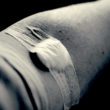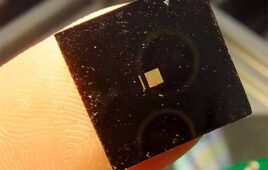
This is an artist’s illustration of nano optical fibers detecting femtonewton-scale forces produced by swimming bacteria. [Image from Rhett S. Miller/UC Regents]
The device is 100 times thinner than a human hair and is made of optical fiber. It is designed to be able to detect forces as small as 160 fN if put in a live Helicobacter pylori bacteria solution. The device can also hear sounds at –30 dB, which is 1,000 times below what humans can hear.
“This work could open up new doors to track small interactions and changes that couldn’t be tracked before,” said Donald Sirbuly, a nanoengineering professor at UCSD Jacobs School of Engineering and leader of the study, in a press release.
Sirbuly suggests that this device could be used for detecting the presence of a single bacterium, monitoring the forming and breaking of bonds, sensing mechanical behavior in cells and as a mini stethoscope to monitor cellular acoustics in vivo.
“We’re not just able to pick up these small forces and sounds, we can quantify them using this device. This is a new tool for high-resolution nanomechanical probing,” said Sirbuly.
The device is made from extremely thin fibers of tin dioxide and coated with a thin layer of a polymer with gold nanoparticle studs. When light travels down the optical fiber, the light interacts with the gold nanoparticle that scatters the light as signals. The signals can be seen with a microscope. The lights are different intensities that change when the fiber is placed in a live cell solution.
Forces and sounds from the cells then hit the gold nanoparticles and fish them into the polymer layer. When they get pushed closer to the fiber, the light interacts strongly with the nanoparticles. The engineers on the study developed the device to match the signal intensities of different force and sound levels.
The polymer layer on the fiber is what makes the device work. Sirbuly suggests that is researchers want to be able to detect larger forces or louder sounds, they would need to use a stiffer polymer coating. If they need it to me more sensitive, they could use a hydrogel or another soft polymer.
The researchers hope to use the nanofibers to measure bioactivity and the behavior of cell mechanics in the future.
The research was published online in the May 15 edition of Nature Photonics.
[Want to stay more on top of MDO content? Subscribe to our weekly e-newsletter.]





